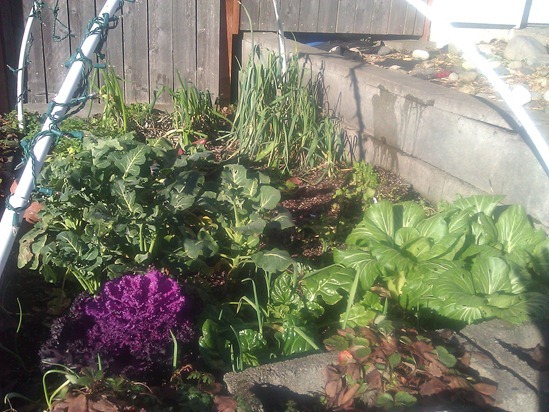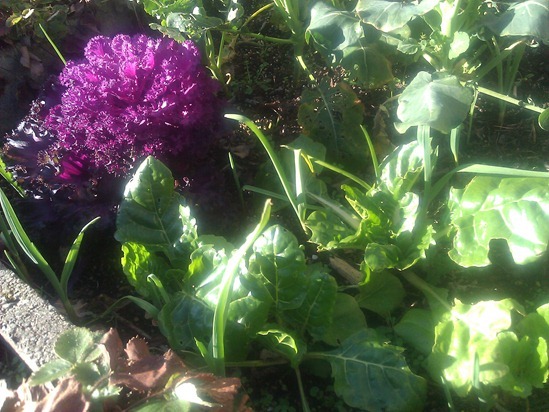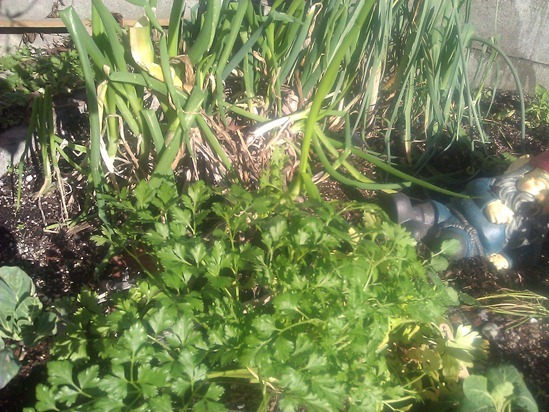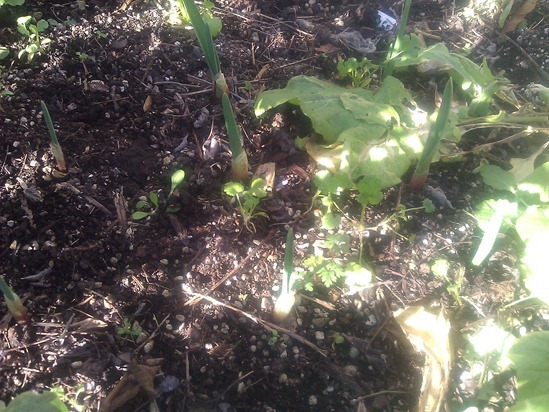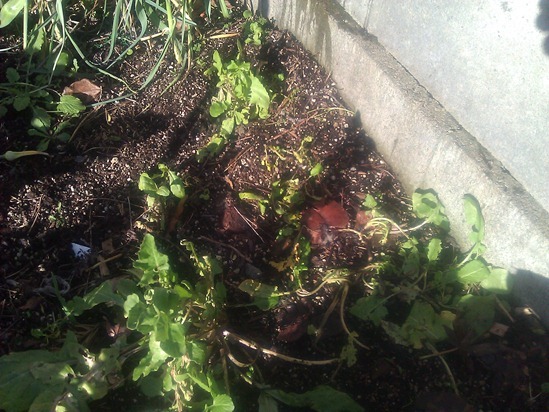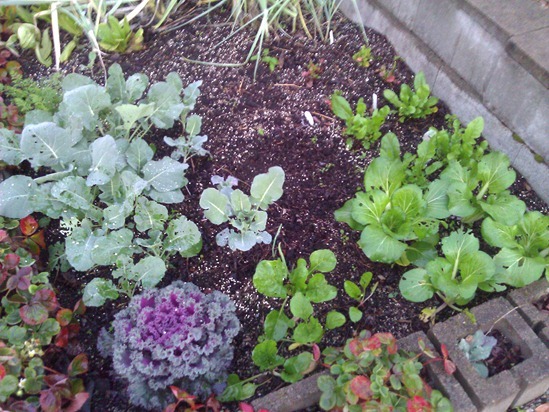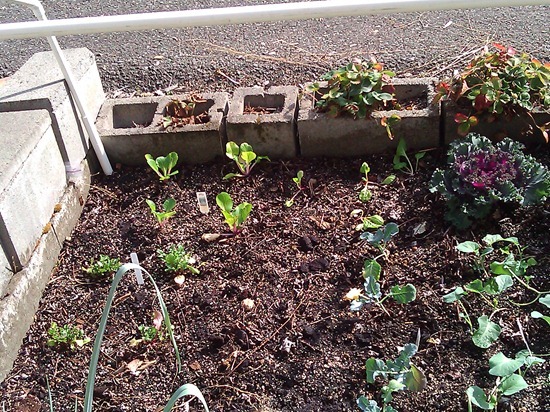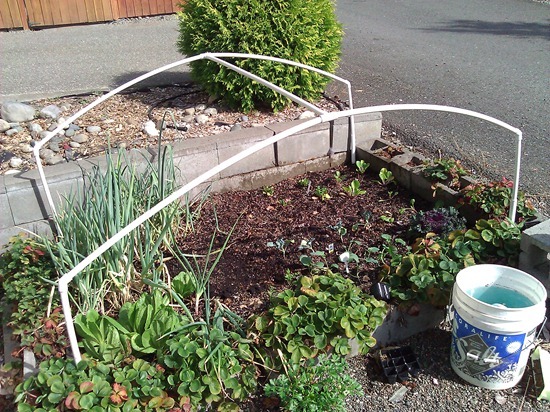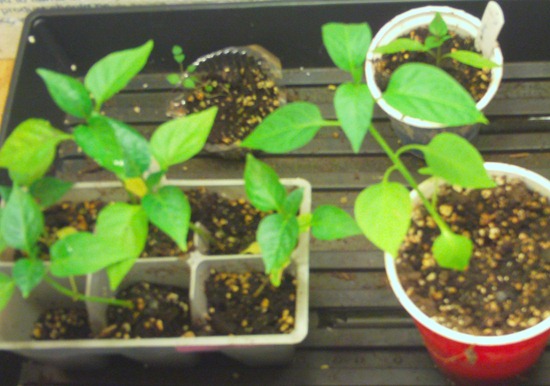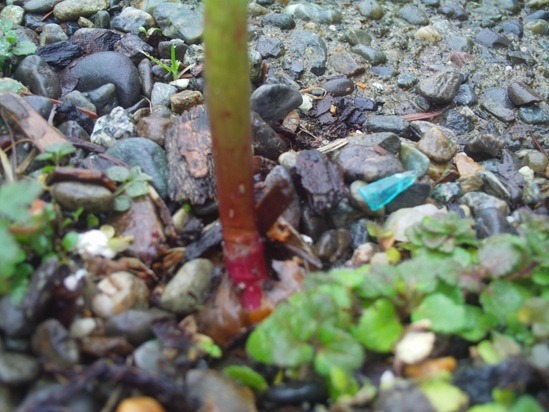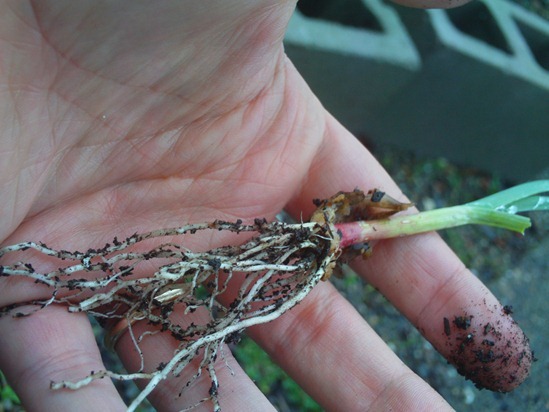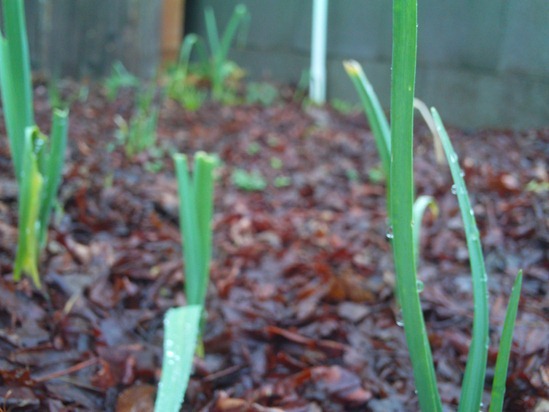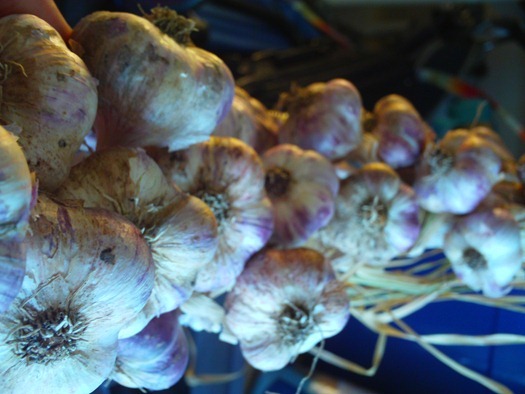Winter garden survivors
12.2 years ago bok choy, garlic bulbs, kale, winter garden
Saturday we had a rare occurrence here in the Pacific Northwest, this large ball of warm gas, which in some areas they refer to as the sun made an appearance. It raised the temperature so much I had to take the cover off my winter garden so I decided to do a little weeding and take some pictures.
The Chinese cabbage (bok choy) is looking great and I need to remember to cook with it shortly.
The kale and Swiss chard is also growing strong…think I might have some cooked greens in my future.
The parsley and onions needed a little cleaning up but still nice and green.
The garlic bulbs planted last fall are now starting to emerge with some stray cilantro in gabs between them.
The arugula is still alive but a little mangled from some of the snow that the hoop cover did not keep entirely off. For the beginning of February the garden looks the most alive it has ever been this time of year.
Quick winter garden update
12.5 years ago bok choy, broccoli, cold season crops, garlic bulbs, winter garden
The weather is starting to get colder (yesterday woke up to 37F) but still in safe ranges for my winter garden which is doing great. An abundance of Kale and arugula and chard and bok choy are getting pretty close to harvest. Broccoli is taking its time like it should.
I also planted some chives, onions which I started from seeds several week ago. I have also planted a bulb worth of garlic to harvest next summer.
What I am growing in my winter garden
12.6 years ago bok choy, cold season crops, garlic bulbs, leeks, lettuce, onions, winter garden
I normally get burned out over the spring/fall and don’t do much for the fall/winter season. This year I decided I want to have a nice selection of winter veggies so I am going all out and start my winter garden.
In the garden now are kale, broccoli, bok choy, carrots, spinach, romaine lettuce, arugula (one of the most profitable vegetables), bunching onions, garlic, and leeks. I wanted to grow Brussel sprouts but I should have started those about 4 month ago.
I grew the lettuce, broccoli, onions, and leeks from seeds in the grow box and transplanted them a few of weeks ago. The bok choy, kale, and arugula were an impulse addition when I saw the plants on sale and struggling at my local grocery store.
All of these plants should do pretty well with the mild winters we get here in the Pacific Northwest…but our hard rains and occasional snowfall could lead to their downfall. For this reason I came up with this structure which when the rains and/or low temperatures come I will cover with 2.5mm plastic sheeting. Though I plan on adding one more set of cross pieces to prevent sagging in the middle, I consider this design a bit of a hybrid between row covers and a full blown hoop house.
This will provide plenty of space for the plants to grow and ease of getting under the structure to harvest in the rain while not large enough to hopefully not catch a little wind and sail away.
I am excited to continue to collect my harvests all year round.
When to bring your vegetables outside?
13.1 years ago garlic bulbs, onions, peppers, seeds, spinach, summer, tomato
Every time I have a discussion with a beginner gardener, this is the most common question. Typically the answer involves figuring out your last frost date then doing some backwards math when to start your seeds or purchase your plants from your local nursery. The problem with this is there is an assumption of the rate at which temperatures will increase after this no frost date. It doesn’t really matter how many weeks after the last frost when you bring out your tomatoes but the fact that it is over 65° F
This is good for estimation but ultimately it comes down to what temperatures various vegetables can survive and thrive at. This is ultimately when you should decide to start bringing those fragile plants outside. For reference the table below shows these temperatures for various vegetables.
| Vegetables | Thriving Temp Range |
Surviving Temp Range |
| Hot Vegetables eggplants, sweet potatoes, peppers, watermelons, okra, tomatoes |
70° F – 85° F 21° C – 30° C |
65° F – 90° F 18° C – 32° C |
| Warm Vegetables beans, black-eyed peas, cucumbers, melons, sweet corn, squashes |
65° F – 75° F 18° C – 24° C |
50° F – 90° F 10° C – 32° C |
| Cold/Warm Vegetables artichokes, beets, broccoli, brussel sprouts, cabbages, carrots, cauliflower, celery, chard, collards, endives, fava beans, fennel, kale, kohlrabi, lettuce, parsnips, peas, potatoes, radishes, rutabagas, spinach, turnips |
60° F – 65° F 16° C – 18° C |
40° F – 75° F 4° C – 24° C |
| Cold Vegetables garlic, leeks, onions, shallots |
55° F – 75° F 13° C – 24° C |
45° F — 85° F 7° C – 30° C |
Now that you know what temperatures your veggies grow best in, unless you can find a news station with a 2-3 month forecast this doesn’t help you too much. Fortunately we have been saving weather data for some time now and with some simple statistics you can make a more logical prediction of when this may occur (compared to last freeze date)
One site that makes this very easy is WeatherSpark, it uses historical data with great visuals to easily determine when the best probability of picking the right date to plan on your veggies going out into the great unknown.
As you can see in my area we rarely stay in the thriving temperature zone during a 24 hour period which is the reason why I personally keep my tomatoes and peppers in my automated grow box as long as I can.
Hopefully WeatherSpark can give you some incites about predicting the best times to bring those veggies out for a successful crop this year.
Tags: seed, starting seedling
Garlic growing in my driveway
13.2 years ago garlic bulbs, spring, sprouting
Just to show our level of rain in the Pacific Northwest, I must have misplaced a couple of garlic cloves when I was braiding my garlic last summer since I noticed 4 garlic plants growing in the gravel next to my driveway.
Even with the less than ideal “soil” they were growing in they have some decent looking root structure. Provided my garden has a no plant left behind policy I dug up each of these garlic plants and found a place for them next to the garlic cloves I intentionally planted in my garden last fall.
Tags: garlic
How to braid garlic (for guys)
13.7 years ago garlic bulbs, Uncategorized
I normally hang my garlic off my bike to allow it to cure and store to use over the winter, but given the large amount of garlic I have grown and I have gotten into better shape and am actually using my bike, I decided to attempt to create a pretty garlic braid. After spending a 10-15 minutes checking on the internet on the various knots and techniques to braid garlic.
Lacking some basic knowledge and first hand experience braiding, I eventually got confused, gave up, and just winged it and discovered a technique I call “Braiding Garlic For Guys” knowing if I handed the bulbs to my two daughters they would have made a perfect braid with them in just a few minutes. And yes, my wife does not trust me to do our daughters hair…
Step 1: Dry your bulbs
Lay them out into the sun to dry for one hot day. You will be letting the garlic dry longer though this is primarily to get the dirt dry on the bulbs to make Step 3 (Clean up your bulbs) a little easier.
Step 2: Select the right bulbs
If you are lucky enough to only grow large perfectly formed bulbs with no imperfections you can skip this step, but if you are like me you should have at least a few bulbs with small cloves or some that are split open. Set these bulbs aside and use right away in your cooking or do like I did and use them to make some garlic powder.
Step 3: Clean up your bulbs (optional)
Though creating a garlic braid is a good compact way to store your garlic it also looks pretty cool when done right. To make sure it looks its best give each of the bulbs a little haircut by trimming their roots to about 1/4 inch using scissors or shears Follow this with a quick cleaning by a little brushing of your hand and/or a quick brush with an unused toothbrush. Given I am just hanging my garlic in my garage I was a little lazy on the clean up.
Step 4: Start your garlic braid
Begin by taking your 3 largest bulbs and laying them side by side in front of you. Take the stems of the bulbs on the left and right and cross them over the one in the center.
Now take whatever stem (right or left) that is on the bottom and bend it over the stem in the center (which now becomes the new center)
Here is an illustration but easier if you don’t think about it too much:
Step 5: Repeat yourself
Give the right and left side a little tug to make everything is tight and lay a new bulb on the middle of your garlic braid (center) then bend over the stem from the other side over the center (which now becomes the new center) and repeat this step until run out of garlic bulbs.
Step 6: Finish things off
Repeat what you have been doing in Step 5 three or four times obviously skipping the add a garlic bulb to help secure the last few bulbs in place. Finish by tightly tying a piece of twine or string at the top of the braid to keep things from unraveling and giving you something to hang your beautiful braid in a dry location to have garlic which will keep for about 6 months.
Tip: When you need some garlic just cut or pull off bulbs as you need them. I personally save the largest bulbs to replant in the fall to harvest the following year.
Tags: garlic
